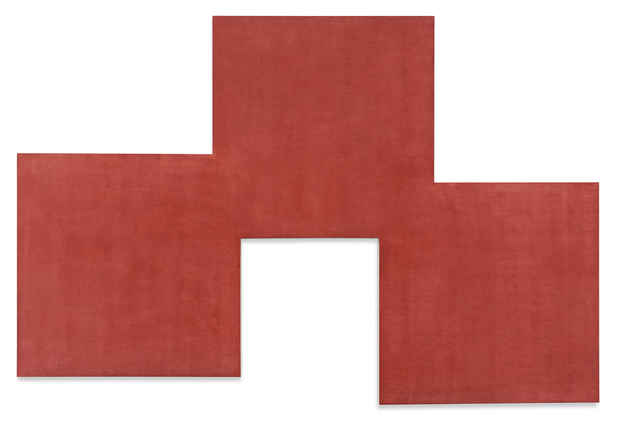Robert Mangold “Paintings 2017–2019”
Pace Gallery (540 W 25th St.)

This event has ended.
Featuring recent works created between 2017–2020, this exhibition brings together never-before-seen paintings that build on the arc of the artist’s oeuvre over the past decade.
This new exhibition, which marks the artist’s sixteenth show at Pace Gallery, features works centering on the formal possibilities of the square and implied space. Distilling Mangold’s lifelong exploration of the perceptual tensions among shape, line, color, and surface, these new works epitomize the conceptual rigor and aesthetic sophistication of his six-decade career, while also demonstrating the artist’s enduring will to probe the fundamental questions of painting.
Driven by experimentation, Mangold’s new body of work reconsiders the implications of some of his most seminal paintings and often breaks with recent precedent. In Two Squares Within a Double Square (2017), for example, the flatness characterizing much of Mangold’s work is disrupted by the presence of a raised square, forcing the painting to engage with three-dimensional space in a manner not seen in Mangold’s art since his Wall paintings of the mid-sixties. With Two Merging Squares (2019), the elegant graphite lines that have served to activate the surfaces of his canvases are no longer required for the work to stage a tension between its tacit internal geometry and the irregular shape of its perimeter. Color, too, undergoes a calculated shift. In works such as 3 Square Structure (2018), Mangold turns away from the neutral shades typical of his work of the sixties but also refrains from replicating the bolder hues of his art of the 1980s, opting instead for a middle ground: a strong yet sober red. Standing before these new works, viewers can experience another of Mangold’s dialectical tours de force—an art simultaneously oriented toward the past and the future.
Mangold rose to prominence in the 1960s as one of the most original and incisive voices shaping the polemics on the new painting of the time. Inspired by Mark Rothko’s atmospheric surfaces and the physicality of Barnett Newman’s monumental works, Mangold strove to create a new, ambiguous type of painting that combined these strengths. Using a spray-gun or roller, he applied oils to lumberyard materials, such as Masonite and plywood, to create smooth, monochromatic canvases in unassuming colors, as seen with his groundbreaking Walls series. Begun in 1963, these works’ visible seams, notched edges, and protrusions simultaneously emphasized a raw materiality, even architectural qualities, reminiscent of New York’s urban structures. Anticipating by two years Donald Judd’s influential theorization of the “specific object” as “neither painting nor sculpture,” Mangold’s work radically emphasized painting’s object-like qualities, narrowing the gap between the flat medium and three-dimensional ones, such as sculpture and architecture.
Robert Mangold, Two Merging Squares, 2019, acrylic on canvas, 44” × 80-1/2” (111.8 cm × 204.5 cm) © 2020 Robert Mangold / Artists Rights Society (ARS), New York
Bearing subtle color gradations, drawn lines, and employing a variety of forms, ensuing works, such as the Areas or V, W, X series, further synthesized a modernist understanding of painting as an illusory, optical surface with a literalist view of the medium as a thing in space. In its evolution, Mangold’s work never becomes predictably linear or dogmatic. Rather, it remains open to the surprising twists and turns of his intuition and curiosity, always referring to his earlier works and often reexamining the questions previously raised. In his essay for the exhibition catalogue, art historian Matthew Levy observes, “To revisit something from the past is often referred to as ‘circling back,’ yet what Mangold achieves with these works is more akin to a spiral—a looping backward to chart a new path into the future.”
To revisit something from the past is often referred to as ‘circling back,’ yet what Mangold achieves with these works is more akin to a spiral—a looping backward to chart a new path into the future.
Since the beginning of his career in the mid-60s, Robert Mangold has combined the classic elements of composition—shape, line, and color—to create abstract works of architectural scale, drawing by hand thick and thin graphite lines on subtly modulated planes of color.
Following his first solo exhibition in 1964, Mangold’s work has been the subject of numerous single-person exhibitions and retrospectives at institutions including the Solomon R. Guggenheim Museum, New York; Stedelijk Museum in Amsterdam; Akron Art Museum; Hallen für neue Kunst, Schaffhausen, Switzerland; Allen Memorial Art Museum, Oberlin College; Hallen für neue Kunst; Museum Wiesbaden; Parasol Unit Foundation for Contemporary Art, London; and Albright-Knox Art Gallery, Buffalo.
Media
Schedule
from September 18, 2020 to October 24, 2020